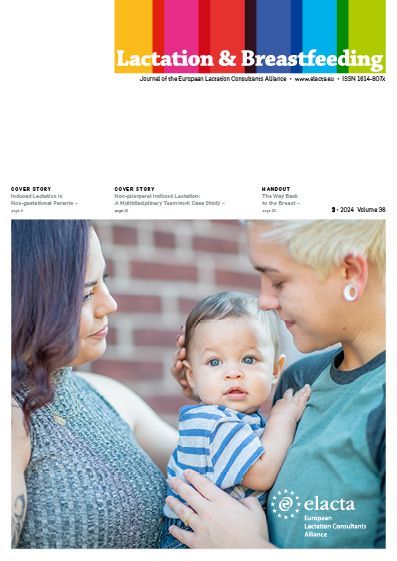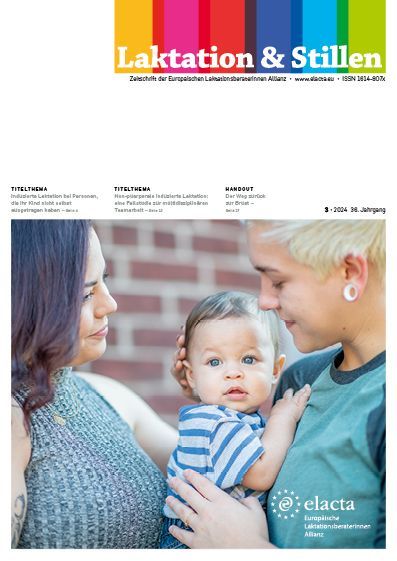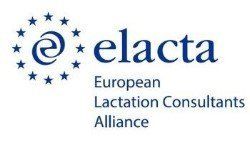
ELACTA bietet ihren Mitgliedern oder den Abonnenten des Fachjournals die Möglichkeit, mit "Laktation & Stillen" ohne zusätzliche Kosten CERPs zu verdienen. Sie sind Abonnent der Zeitschrift Laktation und Stillen oder Mitglied bei ELACTA ? (z.B. BDL, VSLÖ, VSLS, Swilacta) - Dann viel Spaß beim folgenden Test. Keine Sorge Wiederholungen sind möglich. Sie wissen nicht, ob Sie Mitglied bei ELACTA sind? Bitte kontaktieren Sie Ihren Landesverband und fragen Sie nach. Sie sind weder Mitglied noch Abonnent? Bitte buchen Sie vor dem Ausfüllen des Tests ein Abo oder werden Sie Mitglied in einem der ELACTA-Landesverbände. Wenn eine Person, die nicht unter diese Personengruppen fällt, den Test durchführt, stellt ihr ELACTA ein Jahresabo (derzeit € 41,00) plus eine zusätzliche Bearbeitungsgebühr von € 10,00 in Rechnung.

At the heart of our work as lactation consultants are the unique needs and life circumstances of the families we support. It is the diversity of individual back grounds and wishes that makes our work so special and enriching. In this issue, we explore from various perspectives how we can empower families on their very own journeys with openness, empathy, and professional expertise. In her article “Colourful Breastfeeding”, Gabriele Nindl encourages us to think about breastfeeding beyond rigid categories and to appreciate the many possible paths when exclusive breastfeeding is not feasible. Lucia Bliem presents her video project, in which she prepares deaf mothers for breastfeed ing in their native language—sign language. Against the backdrop of current and looming war situations in Europe, Andrea Hemmelmayr introduces an in ternational guideline for the safe feeding of infants and young children in the event of chemical, biological, radiological, and nuclear threats. Two case reports explore the important role of lactation counselling in sensitive clinical situations: Frances Strobl and Melissa Theurich demonstrate that persistent neonatal jaundice in a premature infant may be linked to Gil bert’s syndrome. Bianca Uzun shares the moving experience of a mother who breastfeeds her baby despite having survived breast cancer and undergone a bilateral mastectomy. Muscle and joint pain during breastfeeding is still often associated with myths. As someone affected by rheumatoid arthritis herself, our editorial team member Andrea Hemmelmayr has created a handout with practical tips for dealing with muscle and joint pain during breastfeeding. We hope this issue inspires you to continue encouraging the unique journeys of the families you support with attentiveness, professional clarity, and empathy. May the summer provide you with opportunities to recharge – both for yourself and your loved ones, as well as for your daily work in coun selling.

im Mittelpunkt unserer Arbeit als Stillberater*innen stehen die indi viduellen Bedürfnisse und Lebensrealitäten der Familien, die wir begleiten. Die Vielfalt persönlicher Voraussetzungen und Wünsche macht unsere Tätigkeit so besonders und bereichernd. In diesem Heft beleuchten wir aus unterschiedlichen Blickwinkeln, wie wir Familien mit Offenheit, Empathie und Fachkompetenz für ihren ganz eigenen Weg stärken können. Gabriele Nindl lädt mit ihrem Beitrag „Bunt Stillen“ dazu ein, Stil len jenseits von starren Kategorien zu denken und die vielen möglichen Wege zu würdigen, wenn ausschließliches Stillen nicht umsetzbar ist. Marianne Reber erläutert, wie Leichte Sprache und weitere adressaten gerechte und barrierefreie Kommunikationsmethoden Barrieren in der Stillberatung abbauen und allen Familien Zugang zu wichtigen Infor mationen ermöglichen kann. Lucia Bliem präsentiert ihr Videoprojekt, in dem sie gehörlose Mütter in deren Muttersprache – der Gebärden sprache – auf das Stillen vorbereitet. Vor dem Hintergrund der aktuell existierenden und drohenden Kriegssituationen in Europa stellt Andrea Hemmelmayr einen internationalen Leitfaden zur sicheren Ernährung von Säuglingen und Kleinkindern bei chemischen, biologischen, radio logischen und nuklearen Bedrohungen vor. Zwei Fallberichte widmen sich der wichtigen Aufgabe der Still beratung in sensiblen klinischen Situationen: Frances Strobl und Melissa Theurich zeigen, dass hinter einer anhaltenden Neugeborenen gelbsucht bei einem frühgeborenen Säugling Morbus Meulengracht stecken kann. Bianca Uzun berichtet von der berührenden Erfahrung einer Mutter, die ihr Baby trotz überstandener Brustkrebserkrankung und einer bilateralen Mastektomie stillt. Muskel- und Gelenkschmerzen in der Stillzeit sind noch immer häufig mit dem Mythos „Still-Rheuma“ verknüpft. Als selbst Betroffene hat unser Redaktionsmitglied Andrea Hemmelmayr ein Handout mit praktischen Tipps zum Umgang mit Muskel- und Gelenkschmerzen in der Stillzeit erstellt. Wir hoffen, dieses Heft inspiriert Sie dazu, den individuellen Wegen der Familien, die Sie begleiten, weiterhin mit Aufmerksamkeit, fach licher Klarheit und Einfühlungsvermögen zu begegnen. Zugleich wün schen wir Ihnen, dass der Sommer Ihnen Zeit schenkt, neue Kraft zu schöpfen – für sich selbst, Ihre Lieben und Ihren Beratungsalltag.

Over time, many articles on related topics have been published in our journal. To make your search easier, we have compiled PDF bundles that group together thematically related articles from different issues. Today we would like to introduce the topic bundle “Expressing and Pumping Breast Milk”. The PDF collection contains 10 PDFs, which are also available as individual articles in our shop. In addition, we have also included a bonus handout and supplementary article – both of which are available free of charge on our website. PDF 1: A Plea for Instruction on Hand Expression of the Breast in the early Postpartum Prenatal Colostrum Expression Author: Bettina Kraus, Midwife, IBCLC, Breastfeeding Coordinator Published: 2017;1:13–15 PDF 2: AME: A Tool to Maximize Breastmilk Production in Challenging Cases AME: Antenatal Manual Expression Author: Dr. Gina Weissmann, DMD, RN, IBCLC Published: 2016;4:12–14 PDF 3: Breast Pumps at Low Prices – The New Market Trend In this article, I will focus on the technical differences so that you as a specialist can form an opinion on low price pumps. Author: Marlies Pepe Truffer, Master of Advanced Studies in Product Management, IBCLC Published: 2020;2:4–7 PDF 4: Pump Management Using a Psychosocial Working Model Author: Natalie Groiss, IBCLC Published: 2020;2:8–10 PDF 5: Relaxed Pump Management Relaxed Pump Management Author: Ulrike Giebel, Midwife, IBCL Published: 2020;2:16–19 PDF 6: Milk Expression to Provide Newborns with the Best Start During the COVID-19 Pandemic Author: Silvia Nicoara, IBCLC Published: 2020;2:20–21 PDF 7: Expression of Breast Milk: Experience from a Project in Bangladesh Author: Rukhsana Haider, MBBS, MSc, PhD Published: 2020;3:26–29 PDF 8: Hand Expression and other Manual Techniques in Breastfeeding Counselling A (secret) tip for successful breastfeeding Author: Elisa Steiner, GKKP, IBCLC Published: 2021;1:4–10 Bonusmaterial: B1: Handout – Every Drop Counts – Expressing Your Milk The handout can also be downloaded free of charge from the website: www.elacta-magazine.eu Published: 2020;2:11–12 B2: How are Mothers Coping with Pumped Milk Feeding? Results of an online survey Author: Andrea Hemmelmayr, IBCLC Published: 2020;2:13–1

PDF-Bündel – Milch gewinnen und Abpumpen Im Laufe der Zeit erscheinen in unserer Zeitschrift viele Artikel zu verwandten Themen. Um Ihnen die Suche zu erleichtern, haben wir PDF-Bündel zusammengestellt, in denen thematisch zusammenhängende Beiträge aus verschiedenen Ausgaben gebündelt sind. Heute möchten wir Ihnen das Themenbündel „Milch gewinnen und Abpumpen von Frauenmilch“ vorstellen. Die PDF-Sammlung enthält 10 PDFs, die auch als Einzelartikel in unserem Shop erhältlich sind. Außerdem haben wir zur Komplettierung als Bonus ein Handout und einen ergänzenden Artikel beigefügt – beide sind auch kostenlos auf unserer Website abrufbar. PDF 1: Ein Plädoyer für die Einweisung in die Entleerung der Brust per Hand im frühen Wochenbett Kurzbeschreibung: Es gibt viele Gründe, Frauen in die Gewinnung von Kolostrum per Hand einzuweisen. Autorin: Bettina Kraus, IBCLC Erschienen in Ausgabe: 2017;1:13–15 PDF 2: AME: Eine Möglichkeit zur Steigerung der Muttermilchproduktion bei schwierigen Fällen Kurzbeschreibung: AME (Antenatal Manual Expression) – die vorgeburtliche händische Milchgewinnung kann ein wirkungsvolles Werkzeug sein für jene Mütter, bei denen das Stillen gefährdet ist. Autorin: Gina Weissmann, DMD, RN, IBCLC Erschienen in Ausgabe: 2016;4:12–14 PDF 3: Milchpumpen zu tiefen Preisen – der neue Markttrend Kurzbeschreibung: In diesem Artikel werden die technischen Unterschiede zwischen Billigpumpen und jenen von etablierten Herstellern aufgezeigt. Autorin: Marliese Pepe-Truffer, IBCLC Erschienen in Ausgabe: 2020;2:4–7 PDF 4: Pumpmanagement im psychosozialen Arbeitsmodell Kurzbeschreibung: Es ist hilfreich, das Pumpmanagement auch aus psychosozialer Sicht zu betrachten und die emotionale Komponente bei der Gestaltung der Beratung mit einzubeziehen. Autorin: Natalie Groiss, IBCLC Erschienen in Ausgabe: 2020;2:8–10 PDF 5: Entspanntes Pumpmanagement Kurzbeschreibung: Mütter, die lange Zeit mit der Pumpe Milch gewinnen, brauchen praktikable Tipps, wie sie die mühsame Arbeit des Pumpens in ihren Alltag integrieren können, um möglichst lange für ihr Kind Muttermilch bereitstellen zu können. Autorin: Ulrike Giebel, IBCLC Erschienen in Ausgabe: 2020;2:16–19 PDF 6: Ein optimaler Start ins Leben während der COVID-19-Pandemie dank Milchgewinnung Kurzbeschreibung: Viele interne Protokolle sahen in der COVID-19-Pandemie eine Trennung der Mutter-Kind-Dyade vor. Muttermilchgewinnung scheint in solchen Fällen die einzige Möglichkeit zu sein, das Stillziel der Mutter zu wahren. Autorin: Silvia Nicoara Erschienen in Ausgabe: 2020;2:20–21 PDF 7: Gewinnung von Muttermilch per Hand: Erfahrungen aus einem Projekt in Bangladesch Kurzbeschreibung: Handgewinnung kann insbesondere bei Berufstätigkeit der Mutter eine gute Möglichkeit sein, das Kind weiter ausschließlich mit Muttermilch zu versorgen. Erfahrungsbericht aus einem Projekt mit Fabrikarbeiterinnen in Bangladesch. Autorin: Dr. Rukhsana Haider Erschienen in Ausgabe: 2020;3:26–29 PDF 8: Manuelle Milchgewinnung und weitere manuelle Techniken in der Stillberatung Kurzbeschreibung: Ein (Geheim-)Tipp für eine erfolgreiche Stillzeit. Autorin: Elisa Steiner, IBCLC Erschienen in Ausgabe: 2021;1:4–10 PDF 9: Häusliches Pumpmanagement nach Entlassung eines Frühgeborenen Autorin: Gertrud Gurnig Erschienen in Ausgabe: 2022;2:19–20 PDF 10: Pumpen – die Voraussetzung für Vieles! Autorin: Elke Sams Erschienen in Ausgabe: 2022;2:17–18 Bonusmaterial B1: Handout – Jeder Tropfen zählt – Gewinnen von Muttermilch (Das Handout kann auch gratis heruntergeladen werden) Erschienen in Ausgabe: 2020;2 B2: Wie geht es Müttern beim Pumpstillen? Kurzbeschreibung: Ergebnisse einer Online-Befragung Autorin: Andrea Hemmelmayr, IBCLC (Der Artikel kann auch gratis heruntergeladen werden) Erschienen in Ausgabe: 2020;3:13–15The body content of your post goes here. To edit this text, click on it and delete this default text and start typing your own or paste your own from a different source. Dieses und andere Themenbündel und viele Einzelartikel können sie direkt in unserem Shop kaufen.

A brief reminder about earning CERPs with Lactation & Breastfeeding: The test for Issues 1+2/2024 is only available online until June 30, 2025! After this date, the test can NO LONGER be taken. By completing the test for Issues 1+2/2024, you can earn a total of 3.5 L-CERPs and 0.5 E-CERPs: Topic Area I: 1 CERP Topic Area II: 1 CERP Topic Area IV: 1 CERP Topic Area VII: 1 CERP Advance Notice: The test for Issues 3+4/2024 will remain online until December 31, 2025 . Here, too, you can earn 3.5 L-CERPs and 0.5 E-CERPs (Topic Area IV: 1 CERP; Topic Area V: 1 CERP; Topic Area VI: 1 CERP; Topic Area VII: 1 CERP).

Kurze Erinnerung zum Erwerben von CERPs mit Laktation & Stillen: Der Test für die Ausgaben 1+2/2024 ist nur noch bis zum 30.06.2025 online! Danach kann dieser Test NICHT mehr absolviert werden. Mit dem Test zu den Ausgaben 1+2/2024 können Sie insgesamt 3,5 L-CERPs und 0,5 E-CERPs verdienen: Themenbereich I: 1 CERP Themenbereich II: 1 CERP Themenbereich IV: 1 CERP Themenbereich VII: 1 CERP Vorankündigung: Der Test für die Ausgaben 3+4/2024 bleibt noch bis zum 31.12.2025 online. Auch hier können Sie 3,5 L-CERPs und 0,5 E-CERPs verdienen (Themenbereich IV: 1 CERP; Themenbereich V: 1 CERP; Themenbereich VI: 1 CERP; Themenbereich VII: 1 CERP).

The focus of this issue is on induced lactation and relactation – two related topics that most colleagues rarely encounter in their day-to-day breastfeeding counselling and which are sometimes fraught with uncertainty. There is very little research on induced lactation and relactation at this time of writing – the little available information is based mainly on experience reports and case studies. To expand our knowledge base, we, the editorial team, set out to find authors who are well versed in these topics or can report on interesting case studies. The search was difficult at first; we were turned down time and time again. Finally, we took advantage of the ELACTA congress in Liege in May to reach several hundred participants by means of a questionnaire. This led to success, which means that we have been able to publish a wide range of articles in this issue. We would like to thank all the authors who made their knowledge available to us at such short notice. Karīna Mahļina from Latvia reports on a successful case of relactation using only an electric breast pump, without the baby actually feeding at the breast and without galactagogues (also known as galactogogues). Sharon Silberstein describes her experience with using the Newman-Goldfarb protocols for induced lactation at her breastfeeding practice in the UK. Shereen Mahmoud Abd-El-Ghani Soliman from Egypt and an international team of authors from Italy, Switzerland and the UK with Claudia Gorgati as the first author also use the Newman-Goldfarb protocols for induced lactation. Gorgati and colleagues describe a case study of same-sex parents in which they also consulted a phytotherapist. Shereen Mahmoud Abd-El-Ghani Soliman presents three very different cases of induced lactation in adoptive mothers at her breastfeeding clinic. In her article, Eline Thommelein from Belgium summarises the scientific evidence base for domperidone and other galactagogues that are often used in relactation and induced lactation (and for other indications). The article by our editorial colleague Regina Kincaid from Ireland ‘Are there alternative techniques to test-weighing and deuterium dilution for measuring the rate of breastmilk synthesis?’ picks up on the discussion from issue 1-2024 ‘Putting Science into Practice’ and discusses how the amount of milk produced by the mother can be estimated if 24-hour test weighing appears too laborious. This is a relevant topic, not just for relactation and induced lactation. Finally, here too, in Lactation & Breastfeeding, we bid farewell to Elizabeth Hormann with tributes to her from colleagues and companions. Elizabeth was an important pioneer of breastfeeding promotion, an honorary member of ELACTA and was a translator in the L&B editorial team for many years. With her brochure ‘Relactation’ commissioned by the World Health Organisation, which many colleagues are still working with, she also laid the foundations for the main topic of this issue. We hope that this issue will provide you with useful information in the event that you receive an enquiry about relactation or induced lactation in the near future.

Das Schwerpunktthema dieser Ausgabe sind induzierte Laktation und Relaktation – zwei verwandte Themen, die im Stillberatungsalltag der meisten Kolleg*innen eher selten vorkommen und manchmal mit Unsicherheit behaftet sind. Denn induzierte Laktation und Relaktation sind bislang kaum wissenschaftlich erforscht – das wenige vorhandene Wissen basiert überwiegend auf Erfahrungen und Fallbesprechungen. Zur Erweiterung des Wissensfundus haben wir uns als Redaktionsteam auf die Suche nach Autorinnen gemacht, die sich mit diesen Themen gut auskennen oder über interessante Fallbeispiele berichten können. Die Suche gestaltete sich zunächst mühsam, wir bekamen Absagen über Absagen. Schließlich nutzten wir den ELACTAKongress in Lüttich im Mai, um mit Hilfe eines Fragebogens mehrere hundert Teilnehmerinnen zu erreichen. Dies führte zum Erfolg, sodass wir in diesem Heft ein breites Spektrum an Beiträgen veröffentlichen können. Wir danken allen Autorinnen, die uns ihr Wissen so kurzfristig zur Verfügung gestellt haben. Karīna Mahļina aus Lettland berichtet über eine erfolgreiche Relaktation im Wesentlichen nur mithilfe einer elektrischen Milchpumpe, ohne dass das Baby effektiv an der Brust getrunken hätte und auch ohne Galaktagoga (auch Galaktogoga genannt). Sharon Silberstein schildert ihre Erfahrungen zum Thema induzierte Laktation mithilfe der Newman-Goldfarb-Protokolle aus ihrer Stillpraxis in Großbritannien. Auch Shereen Mahmoud Abd-El-Ghani Soliman aus Ägypten und ein internationales Autorinnenteam aus Italien, der Schweiz und Großbritannien mit Claudia Gorgati als Erstautorin verwenden die Newman-Goldfarb-Protokolle für induzierte Laktation. Claudia Gorgati und Kolleginnen beschreiben ein Fallbeispiel bei gleichgeschlechtlichen Eltern, bei dem sie auch eine Phytotherapeutin herangezogen haben. Shereen Mahmoud Abd-El-Ghani Soliman präsentiert drei ganz unterschiedliche Fälle von induzierter Laktation bei Adoptivmüttern in ihrer Stillklinik. Eline Thommelein aus Belgien fasst in einem Artikel die wissenschaftliche Studienlage zu Domperidon und weiteren Galaktagoga zusammen, welche bei Relaktation und induzierter Laktation neben weiteren Indikationen oft eingesetzt werden. Der Artikel unserer Redaktionskollegin Regina Kincaid aus Irland „Alternative Bestimmung der Milchbildung“ knüpft an die Diskussion aus dem Heft 1-2024 „Wissenschaft in die Praxis“ an und diskutiert, wie die gebildete Milchmenge der Mutter eingeschätzt werden kann, wenn 24-Stunden-Wiegeproben zu mühsam erscheinen. Ein relevantes Thema, nicht nur in Bezug auf Relaktation und induzierte Laktation. Schließlich nehmen wir auch hier, bei Laktation & Stillen, Abschied von Elizabeth Hormann mit ihr gewidmeten Erinnerungen von Kolleginnen und Wegbegleiterinnen. Elizabeth war eine bedeutende Pionierin der Stillförderung, Ehrenmitglied von ELACTA und langjährige Übersetzerin des L&S-Redaktionsteams. Mit ihrem Werk „Relactation“ im Auftrag der Weltgesundheitsorganisation hat sie auch Grundlagen zum Schwerpunktthema dieser Ausgabe gelegt, mit denen viele Kolleginnen nach wie vor arbeiten1. Wir hoffen, dass wir Ihnen mit dieser Ausgabe eine nützliche Hilfestellung bieten können für den Fall, dass Sie in naher Zukunft eine Anfrage zum Thema Relaktation oder induzierte Laktation erhalten.

We are deeply saddened to announce the loss of a very important member of the breastfeeding community. Elizabeth Hormann passed away on 6 June 2024. The Lactation & Breastfeeding team had the immense honour of working closely with Elizabeth Hormann as a translator for many years. She was a shining example to us, both professionally and personally. As the first IBCLC in Europe, as a lecturer on breastfeeding knowledge and as an assessor for BFHI, she laid important foundations which we can build on today. In 2016, ELACTA honoured her life's work with an honorary membership. We would like to share with you all the interview Elizabeth gave us for issue 4/2018: "50 years ago, she dove into the breastfeeding world - ..."


